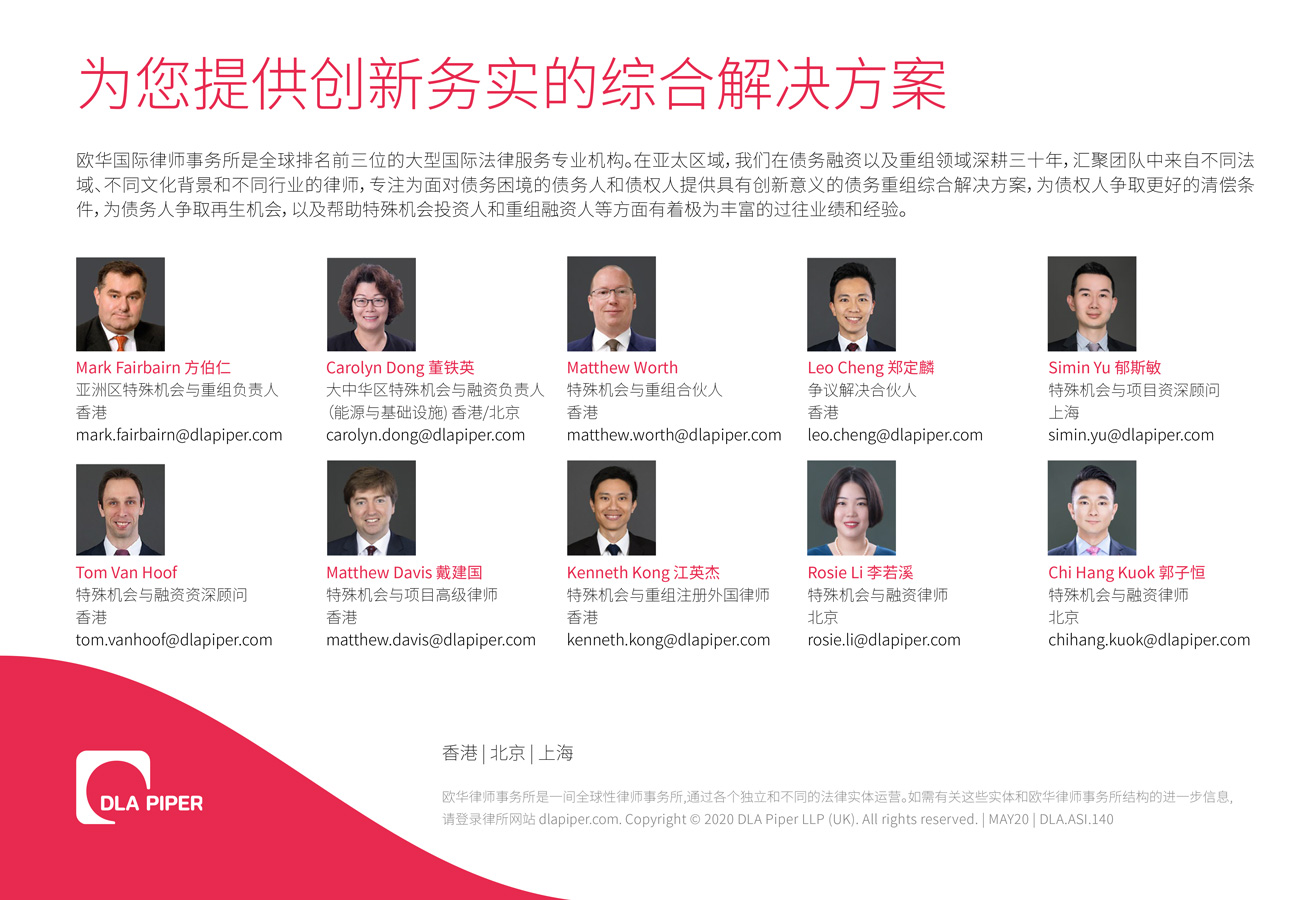This article examines options to improve liquidity and effect restructurings at a time when COVID-19 is causing economic pain on an unprecedented scale.
Liquidity considerations
Working capital is the lifeblood of any company and, given current economic uncertainty, it is possible that debtors and creditors may be equally motivated to agree on steps necessary to improve liquidity in order to avoid a liquidation. Possible steps include:
COVID-19 relief: Are relief measures available from government or banks to assist group companies by jurisdiction?

Standstill: Is a standstill or forbearance with creditors possible?
Landlords: Can terms reducing or deferring expenses be agreed? Can the property be surrendered without penalty?
Exchanges: Can existing debt securities be exchanged into new securities with longer maturity (perhaps involving some “haircut”)? Can interest payments be converted into payment-in-kind (PIK) obligations?
Asset disposals: Can assets be sold while observing covenants in credit documentation restricting the use of the proceeds and avoiding the trigger of EBITDA (earnings before interest, taxes, depreciation and amortization) thresholds?

Amend and extend: Can interest/principal payments be deferred and/or maturity extended while noting restrictions and voting thresholds in credit documentation?
Reset covenants: Can waivers of financial covenants be agreed, given the “new normal”?
New money: Are assets available to be used as collateral e.g., receivables? Will existing lenders, shareholders or other debt investors advance new capital (perhaps in the form of convertible notes)? Are personal guarantees available?
Debt/equity swap: Will creditors swap debt into equity?
Debt purchase: Is there any prospect that a company can purchase its own indebtedness in the secondary market at a discount, prior to cancellation or exchange?
Housekeeping: Prepare cash flow statements, management accounts, financial projections, operational business plans, check provisions in credit documentation preventing drawdown or triggering default. Stress test all outcomes. Keep written minutes of all decisions.
Directors must remain mindful of their fiduciary/statutory duties. From a common law perspective, when a company is, or may become, unable to pay its debts as they fall due, directors must consider the best interests of creditors, rather than any other stakeholder (including shareholders).
Restructuring possibilities
Inevitably, a restructuring may be the only option, and, relevantly, the structure of companies in mainland China and the Hong Kong SAR is more complex than during preceding crises. It is common for a company listed in Hong Kong to be incorporated offshore (say, in Bermuda), to have its key businesses elsewhere, and to have issued debt securities (governed by New York or English law), which themselves may be listed in Singapore.
Each factor “connecting” a company to a different country creates the possibility of taking advantage of restructuring regimes in the country most favourable to it. This is known as “insolvency tourism”.
Insolvency tourism
A company listed in Hong Kong, in theory, could seek to effect a restructuring in: (1) Hong Kong; (2) its place of incorporation (if it is not Hong Kong); (3) England or the US if credit documentation is governed by those jurisdictions; or (4) another jurisdiction where it has its COMI (centre of main interests).
In examining each option, it is necessary to analyse the basis of submission to each jurisdiction, and judicial co-operation between courts.
Submission to jurisdiction
Common law countries assert jurisdiction over any company (regardless of place of incorporation) where there is sufficient connection. A connection may be as simple as the debtor being a party to a contract governed by the laws of that country. This flexibility has been the cornerstone of many restructurings in England of companies based in continental Europe in the past decade.
Judicial co-operation
Restructuring proceedings can be commenced in multiple countries over the same debtor. It is for this reason that the UNCITRAL (United Nations Commission on International Trade Law) Model Law outlines the basis for dealing with distressed companies with businesses in multiple jurisdictions. Many countries have adopted the Model Law (the US, UK, Japan, Singapore, South Korea etc.) but mainland China and Hong Kong have not.
Article 5 of the Enterprise Bankruptcy Law concerns the recognition of international insolvency proceedings. There is no equivalent in Hong Kong, but the court has used the common law and principles of judicial comity. In a case about the Joint and Several Liquidators of CEFC Shanghai International Group, the Court of First Instance set out principles relevant to the recognition of foreign insolvency proceedings (in this case, insolvency proceedings commenced on mainland China). The case held that:
- The foreign proceeding must be a collective insolvency proceeding opened in the place of incorporation; and
- If the court offers any assistance, it will not grant a foreign liquidator all powers as are available to a liquidator appointed in Hong Kong.
The court suggested reciprocity with mainland courts would be an important consideration in similar cases in the future.
Which jurisdiction and process?
Companies should not limit themselves to the place of incorporation. All possible venues should be examined. Relevant issues to understand include:
- Scope of the stay/ moratorium;
- Creditor voting thresholds to approve a restructuring;
- Ability to “cram down” different creditor groups;
- Availability of super priority financing and subordination of existing security;
- Rule in Gibbs – an English common law principle requiring contractual obligations to be discharged by unanimous consent, or a proceeding commenced in the jurisdiction of the governing law of the contract; and
- Speed and cost.
Frequent international restructuring processes include:
Scheme of arrangement: A court-sanctioned compromise between the debtor and its creditors. Once sanctioned, all creditors are bound, even those who voted against. Schemes are common in bond restructurings.
Provisional liquidation: The appointment of provisional liquidators to pursue a restructuring under the umbrella of a stay. In certain “light touch” proceedings, existing management can remain in office.
Chapter 11: Upon filing, there is an extensive automatic stay. Management usually remains in office. There is an enormous pool of capital available to assist distressed companies to obtain debtor-in-possession (DIP) financing.
Conclusion
Globalization has created options for companies, and exploring each option may help preserve the most value for stakeholders.
Mark Fairbairn is a partner and head of special situation and restructuring, Asia at DLA Piper. He can be contacted at +85294336534 or by email at mark.fairbairn@dlapiper.com.
Carolyn Dong is head of special situation and finance (energy and infrastructure), Greater China, and global board member at DLA Piper. She can be contacted at +86 1580 1288 471 (Wechat), or by email at carolyn.dong@dlapiper.com






















